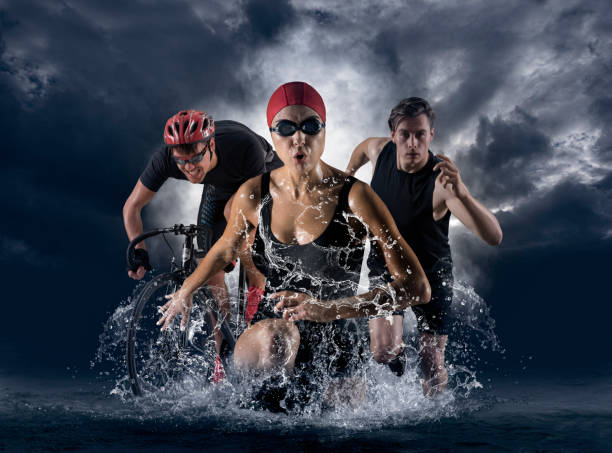The Ultimate Guide to Triathlon Shoes: What Every Triathlete Needs to Know (2025 Edition)
What Do Triathletes Wear on Their Feet?
Triathletes typically wear lightweight, breathable running shoes that prioritise comfort, performance, and speed during transitions. Shoes with quick-lacing systems such as elastic laces or BOA dials save valuable seconds compared to traditional laces. Some athletes choose to skip socks entirely to reduce transition time, while others wear thin, moisture-wicking, blister-resistant socks for comfort, particularly in longer events. Ultimately, the goal is to strike a balance between speed, support, and protection for your feet.
What Makes a Triathlon Shoe Different?
Triathlon shoes are specifically designed to make transitions faster and running more efficient. These shoes often have a wider foot opening and minimal fastenings—typically one or two Velcro straps or BOA dials—so that you can slide your foot in easily, even when wet. Quick-drying mesh uppers allow water to drain and help your feet stay light and comfortable, while the lightweight construction ensures minimal energy expenditure throughout the race. In short, triathlon shoes are optimised for performance under the unique demands of multisport racing.
What Are the Rules for Triathlon Shoes?
Triathlon shoe rules exist to maintain fairness and prevent performance advantages from untested prototypes. Shoes must have a midsole thickness of no more than 40mm and contain no more than one rigid embedded plate. They also need to be commercially available for a set period before being used in competition. Governing bodies like World Triathlon and IRONMAN enforce these rules through random checks and published banned lists. These regulations prevent a "technological arms race" and ensure that all athletes compete on a level playing field, balancing performance with fairness.
Why the Rules Exist
The rules are designed to protect the integrity of the sport. Limiting stack height and plate numbers prevents certain shoes from giving an unfair advantage, ensuring that success is based on an athlete's fitness, skill, and strategy rather than experimental footwear technology. Understanding these rules helps athletes make informed choices about gear while staying compliant during competitions.
Why Are Certain Running Shoes Banned in Triathlon?
Running shoes are prohibited if they exceed 40mm stack height or contain more than one rigid plate, as this could provide an unfair mechanical advantage. Using non-compliant shoes risks disqualification, making it critical for triathletes to always verify their shoe choice against official regulations before race day.
What Shoes Are Best for Triathlon?
Choosing the right shoe depends on your race distance, running style, and personal preferences. The top triathlon shoes for 2025 offer a combination of speed, comfort, quick transitions, and compliance with race regulations.
Top Triathlon Running Shoes of 2025
Here are the best triathlon shoes this year, each offering unique benefits depending on your race goals:
Nike Vaporfly 4 – Best Overall
Key Features: ZoomX foam midsole for lightweight cushioning, full-length carbon plate for propulsion, breathable Atomknit upper.
Why It’s Great for Triathlon: Combines speed, comfort, and efficiency, making it perfect for both Olympic and long-course triathlons.ASICS Noosa Tri 16 – Best Traction
Key Features: AHAR+ outsole for grip, lightweight FF Blast+ cushioning, tri-specific easy-entry heel tabs.
Why It’s Great: Excels in wet or mixed conditions, giving athletes stability during quick dismounts and transitions.New Balance FuelCell SuperComp Elite v4 – Most Versatile
Key Features: FuelCell midsole with Energy Arc carbon plate, ultra-light engineered mesh upper.
Why It’s Great: Ideal for both short sprints and Ironman distances, balancing speed, support, and comfort.Nike Alphafly 3 – Best for Ironman
Key Features: Dual Air Zoom pods, full-length ZoomX cushioning, stabilised carbon plate.
Why It’s Great: Superior energy return and cushioning make it perfect for the marathon leg of long-course triathlons.Hoka Cielo X1 Race Shoes – Ultimate Cushioning
Key Features: High-stack PROFLY-X midsole with carbon plate, ultra-lightweight upper.
Why It’s Great: Cushioned enough for recovery and long distances while still delivering a responsive and fast ride.Saucony Endorphin Pro 3 – Top Race-Day Performance
Key Features: PWRRUNPB foam, S-curve carbon plate, SPEEDROLL geometry for effortless forward motion.
Why It’s Great: Feels snappy and responsive, perfect for sprint or Olympic triathlons.Brooks Hyperion Max 2 – Best for Training & Racing
Key Features: DNA FLASH midsole with nitrogen infusion, durable outsole, breathable mesh upper.
Why It’s Great: A balanced trainer-racer that supports both daily prep runs and race-day performance.On Cloudboom Echo 3 – Superior Energy Return
Key Features: Helion HF superfoam, full-length carbon plate, ultra-light mesh upper.
Why It’s Great: Featherlight with a springy ride, perfect for fast triathlons and short-distance races.ASICS Metaspeed Sky Paris – Lightweight Long-Distance Option
Key Features: FF Turbo cushioning, carbon propulsion plate, highly breathable upper.
Why It’s Great: Designed for efficient stride extension, ideal for the marathon leg of Ironman and long-distance triathlons.Salomon S/LAB Phantasm 2 – Fast & Responsive
Key Features: Energy Surge foam midsole, R-Camber rocker geometry, lightweight mesh upper.
Why It’s Great: Minimalist, responsive, and built for speed, making it a strong contender for race-day performance.
Key Factors When Choosing Your Shoe
When selecting triathlon shoes, consider your race distance, fit, comfort, traction, and lacing system. Longer races require more cushioning and support, while sprints benefit from lightweight, fast shoes. Proper fit is essential to avoid blisters, especially when running without socks, and traction ensures stability on wet surfaces. Quick-lace systems or elastic laces save valuable transition time, and water-friendly materials help your feet stay dry and comfortable throughout the race.
Final Thoughts
Triathlon shoes are more than just footwear—they’re an integral part of your performance strategy. From improving transitions to supporting your stride and energy return, the right shoes help you perform at your best from start to finish. Selecting race-legal, comfortable, and performance-focused shoes is essential for triathletes looking to achieve personal bests and enjoy a smoother, faster race experience.
For triathletes in Adelaide seeking expert guidance or the perfect triathlon shoe, visit RunDNA for professional fittings here or explore their complete running shoe selection here.

Comments
Post a Comment